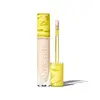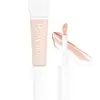Kosas Revealer Super Creamy + Brightening Concealer Versus Huda Beauty GloWish Bright Light Hydrating Sheer Vegan Concealer
What's inside
What's inside
 Key Ingredients
Key Ingredients

 Benefits
Benefits

 Concerns
Concerns

 Ingredients Side-by-side
Ingredients Side-by-side

Water
Skin ConditioningCaprylic/Capric Triglyceride
MaskingMica
Cosmetic ColorantOctyldodecanol
EmollientPolyglyceryl-2 Dipolyhydroxystearate
Skin ConditioningEthylhexyl Olivate
Skin ConditioningUndecane
EmollientGlycerin
HumectantPolyhydroxystearic Acid
EmulsifyingTridecane
PerfumingPolyglyceryl-3 Diisostearate
EmulsifyingGalactoarabinan
Helianthus Annuus Seed Wax
Skin ConditioningArnica Montana Flower Extract
MaskingCaffeine
Skin ConditioningDunaliella Salina Extract
Skin ConditioningFoeniculum Vulgare Oil
EmollientGlyceryl Oleate
EmollientHelianthus Annuus Seed Oil
EmollientLecithin
EmollientMaltodextrin
AbsorbentPalmitoyl Tripeptide-5
Skin ConditioningPanthenol
Skin ConditioningRosmarinus Officinalis Extract
AntimicrobialSodium Hyaluronate
HumectantSqualane
EmollientTocopherol
AntioxidantPotassium Sorbate
PreservativeSodium Benzoate
MaskingWater, Caprylic/Capric Triglyceride, Mica, Octyldodecanol, Polyglyceryl-2 Dipolyhydroxystearate, Ethylhexyl Olivate, Undecane, Glycerin, Polyhydroxystearic Acid, Tridecane, Polyglyceryl-3 Diisostearate, Galactoarabinan, Helianthus Annuus Seed Wax, Arnica Montana Flower Extract, Caffeine, Dunaliella Salina Extract, Foeniculum Vulgare Oil, Glyceryl Oleate, Helianthus Annuus Seed Oil, Lecithin, Maltodextrin, Palmitoyl Tripeptide-5, Panthenol, Rosmarinus Officinalis Extract, Sodium Hyaluronate, Squalane, Tocopherol, Potassium Sorbate, Sodium Benzoate
Water
Skin ConditioningC9-12 Alkane
SolventDicaprylyl Ether
EmollientUndecane
EmollientPropanediol
SolventDicaprylyl Carbonate
EmollientPolyglyceryl-6 Polyricinoleate
EmulsifyingPentylene Glycol
Skin ConditioningVaccinium Myrtillus Seed Oil
Skin ConditioningTridecane
PerfumingVp/Hexadecene Copolymer
Zinc Stearate
Cosmetic ColorantDisteardimonium Hectorite
StabilisingCaffeine
Skin ConditioningOpuntia Ficus-Indica Stem Extract
Skin ConditioningPrunus Amygdalus Dulcis Oil
Skin ConditioningSodium Hyaluronate
HumectantTocopherol
AntioxidantPolyglyceryl-2 Isostearate
EmulsifyingMica
Cosmetic ColorantCoco-Caprylate/Caprate
EmollientMagnesium Sulfate
Octyldodecanol
EmollientSodium Dehydroacetate
PreservativeLecithin
EmollientGlycerin
HumectantSodium Benzoate
MaskingSynthetic Fluorphlogopite
Potassium Sorbate
PreservativeHydrogenated Lecithin
EmulsifyingAscorbyl Palmitate
AntioxidantStearic Acid
CleansingCitric Acid
BufferingTin Oxide
AbrasiveCI 77491
Cosmetic ColorantIron Oxides
Titanium Dioxide
Cosmetic ColorantWater, C9-12 Alkane, Dicaprylyl Ether, Undecane, Propanediol, Dicaprylyl Carbonate, Polyglyceryl-6 Polyricinoleate, Pentylene Glycol, Vaccinium Myrtillus Seed Oil, Tridecane, Vp/Hexadecene Copolymer, Zinc Stearate, Disteardimonium Hectorite, Caffeine, Opuntia Ficus-Indica Stem Extract, Prunus Amygdalus Dulcis Oil, Sodium Hyaluronate, Tocopherol, Polyglyceryl-2 Isostearate, Mica, Coco-Caprylate/Caprate, Magnesium Sulfate, Octyldodecanol, Sodium Dehydroacetate, Lecithin, Glycerin, Sodium Benzoate, Synthetic Fluorphlogopite, Potassium Sorbate, Hydrogenated Lecithin, Ascorbyl Palmitate, Stearic Acid, Citric Acid, Tin Oxide, CI 77491, Iron Oxides, Titanium Dioxide
 Reviews
Reviews

Ingredients Explained
These ingredients are found in both products.
Ingredients higher up in an ingredient list are typically present in a larger amount.
Caffeine is most associated with coffee, tea, and cacao. In skincare, it helps with calming inflammation and is rich in antioxidants.
While caffeine is used to treat cellulite and and dark circles, further studies are needed to prove this. It has been believed to help with these skin conditions due to its ability to dilate blood vessels and increase blood flow.
Some studies are looking into caffeine's ability to protect against UV rays.
Learn more about CaffeineGlycerin is already naturally found in your skin. It helps moisturize and protect your skin.
A study from 2016 found glycerin to be more effective as a humectant than AHAs and hyaluronic acid.
As a humectant, it helps the skin stay hydrated by pulling moisture to your skin. The low molecular weight of glycerin allows it to pull moisture into the deeper layers of your skin.
Hydrated skin improves your skin barrier; Your skin barrier helps protect against irritants and bacteria.
Glycerin has also been found to have antimicrobial and antiviral properties. Due to these properties, glycerin is often used in wound and burn treatments.
In cosmetics, glycerin is usually derived from plants such as soybean or palm. However, it can also be sourced from animals, such as tallow or animal fat.
This ingredient is organic, colorless, odorless, and non-toxic.
Glycerin is the name for this ingredient in American English. British English uses Glycerol/Glycerine.
Learn more about GlycerinLecithin is a term for a group of substances found in the cell membranes of plants, animals, and humans. They are made up of mixture of phospholipids.
This ingredient has emollient and emulsifying properties.
As an emollient, lecithen helps soften the skin and creates a barrier to keep moisture in.
As an emulsifier, it also helps prevent water and oil ingredients from separating. Lecithin can also help ingredients be better absorbed by the skin.
This is because the phospholipids in lecithin produce liposomes. Liposomes help other ingredients get through the skin barrier.
Depending on the source of this ingredient, lecithin may not be fungal acne safe. This is because some sources of lecithin come from soybean oil, which may feed the malassezia yeast that feeds fungal acne.
We recommend reaching out to the brand you are purchasing from to inquire about the source of their lecithin.
Some other names for this ingredient include soy lecithin and deoiled soy lecithin.
Learn more about LecithinMica is a naturally occurring mineral used to add shimmer and color in cosmetics. It can also help improve the texture of a product or give it an opaque, white/silver color.
Serecite is the name for very fine but ragged grains of mica.
This ingredient is often coated with metal oxides like titanium dioxide. Trace amounts of heavy metals may be found in mica, but these metals are not harmful in our personal products.
Mica has been used since prehistoric times throughout the world. Ancient Egyptian, Indian, Greek, Roman, Aztec, and Chinese civilizations have used mica.
Learn more about MicaOctyldodecanol is a fatty alcohol. It is primarily used to enhance the texture of products.
As an emulsifier, Octyldodecanol helps prevent the oils and waters from separating. It also prevents ingredients from creating foam when shaken.
Octyldodecanol is created by reducing fatty acid to an alcohol.
Due to its high molecular weight, it does not get absorbed into the skin.
Learn more about OctyldodecanolPotassium Sorbate is a preservative used to prevent yeast and mold in products. It is commonly found in both cosmetic and food products.
This ingredient comes from potassium salt derived from sorbic acid. Sorbic acid is a natural antibiotic and effective against fungus.
Both potassium sorbate and sorbic acid can be found in baked goods, cheeses, dried meats, dried fruit, ice cream, pickles, wine, yogurt, and more.
You'll often find this ingredient used with other preservatives.
Learn more about Potassium SorbateSodium Benzoate is a preservative. It's used in both cosmetic and food products to inhibit the growth of mold and bacteria. It is typically produced synthetically.
Both the US FDA and EU Health Committee have approved the use of sodium benzoate. In the US, levels of 0.1% (of the total product) are allowed.
Sodium benzoate works as a preservative by inhibiting the growth of bacteria inside of cells. It prevents the cell from fermenting a type of sugar using an enzyme called phosphofructokinase.
It is the salt of benzoic acid. Foods containing sodium benzoate include soda, salad dressings, condiments, fruit juices, wines, and snack foods.
Studies for using ascorbic acid and sodium benzoate in cosmetics are lacking, especially in skincare routines with multiple steps.
We always recommend speaking with a professional, such as a dermatologist, if you have any concerns.
Learn more about Sodium BenzoateSodium Hyaluronate is hyaluronic acid's salt form. It is commonly derived from the sodium salt of hyaluronic acid.
Like hyaluronic acid, it is great at holding water and acts as a humectant. This makes it a great skin hydrating ingredient.
Sodium Hyaluronate is naturally occurring in our bodies and is mostly found in eye fluid and joints.
These are some other common types of Hyaluronic Acid:
Learn more about Sodium HyaluronateTocopherol (also known as Vitamin E) is a common antioxidant used to help protect the skin from free-radicals and strengthen the skin barrier. It's also fat soluble - this means our skin is great at absorbing it.
Vitamin E also helps keep your natural skin lipids healthy. Your lipid skin barrier naturally consists of lipids, ceramides, and fatty acids. Vitamin E offers extra protection for your skin’s lipid barrier, keeping your skin healthy and nourished.
Another benefit is a bit of UV protection. Vitamin E helps reduce the damage caused by UVB rays. (It should not replace your sunscreen). Combining it with Vitamin C can decrease sunburned cells and hyperpigmentation after UV exposure.
You might have noticed Vitamin E + C often paired together. This is because it is great at stabilizing Vitamin C. Using the two together helps increase the effectiveness of both ingredients.
There are often claims that Vitamin E can reduce/prevent scarring, but these claims haven't been confirmed by scientific research.
Learn more about TocopherolTridecane is a lightweight emollient and fragrancing ingredient. It is a paraffin and often called a silicone alternative.
According to official INCI guidelines, this ingredient is used to give a light odor to raw materials. It is often used as a starter ingredient to create parfum.
This ingredient can be derived from palm oil, or coconut oil. It is also naturally found in certain species of organisms.
According to the NOAA, this ingredient can cause skin sensitivity with prolonged use. However, this warning is taken from the Coast Guard and no studies have been done on this in relation to cosmetics.
Tridecane is not water soluble.
Learn more about TridecaneUndecane is an emollient and helps create a lightweight base for products.
Is is not soluble in water and naturally occurring in some species.
Water. It's the most common cosmetic ingredient of all. You'll usually see it at the top of ingredient lists, meaning that it makes up the largest part of the product.
So why is it so popular? Water most often acts as a solvent - this means that it helps dissolve other ingredients into the formulation.
You'll also recognize water as that liquid we all need to stay alive. If you see this, drink a glass of water. Stay hydrated!
Learn more about Water